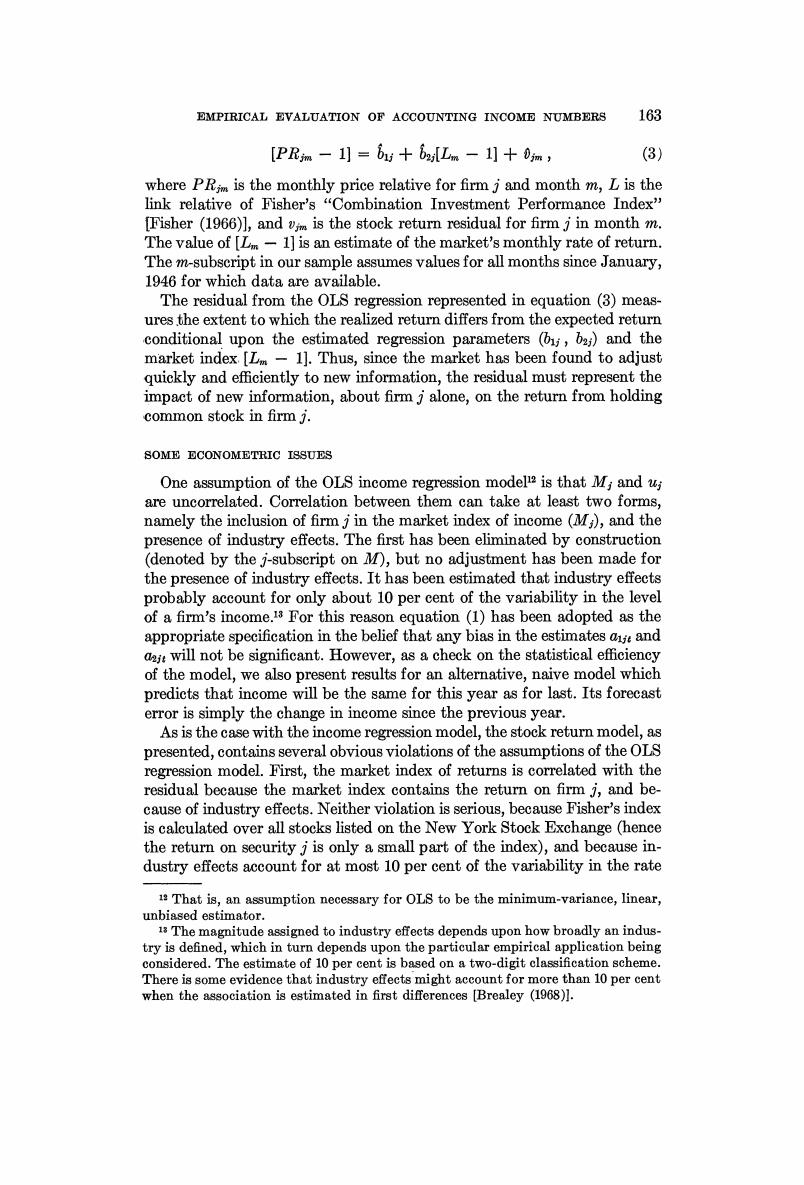
EMPIRICAL EVALUATION OF ACCOUNTING INCOME NUMBERS 163 [PRm-1]=i;+b2d[Lm-1]+0m, (3) where PRim is the monthly price relative for firm j and month m,L is the link relative of Fisher's "Combination Investment Performance Index" [Fisher (1966)],and jm is the stock return residual for firm j in month m. The value of [Lm-1]is an estimate of the market's monthly rate of return. The m-subscript in our sample assumes values for all months since January, 1946 for which data are available. The residual from the OLS regression represented in equation (3)meas- ures the extent to which the realized return differs from the expected return conditional upon the estimated regression parameters (,ba and the market index.[Lm-1].Thus,since the market has been found to adjust quickly and efficiently to new information,the residual must represent the impact of new information,about firm j alone,on the return from holding common stock in firm j. SOME ECONOMETRIC ISSUES One assumption of the OLS income regression model12 is that M;and u; are uncorrelated.Correlation between them can take at least two forms, namely the inclusion of firm j in the market index of income (M;),and the presence of industry effects.The first has been eliminated by construction (denoted by the j-subscript on M),but no adjustment has been made for the presence of industry effects.It has been estimated that industry effects probably account for only about 10 per cent of the variability in the level of a firm's income.1 For this reason equation (1)has been adopted as the appropriate specification in the belief that any bias in the estimates au and aas will not be significant.However,as a check on the statistical efficiency of the model,we also present results for an alternative,naive model which predicts that income will be the same for this year as for last.Its forecast error is simply the change in income since the previous year. As is the case with the income regression model,the stock return model,as presented,contains several obvious violations of the assumptions of the OLS regression model.First,the market index of returns is correlated with the residual because the market index contains the return on firm j,and be- cause of industry effects.Neither violation is serious,because Fisher's index is calculated over all stocks listed on the New York Stock Exchange (hence the return on security j is only a small part of the index),and because in- dustry effects account for at most 10 per cent of the variability in the rate 1That is,an assumption necessary for OLS to be the minimum-variance,linear, unbiased estimator. 1s The magnitude assigned to industry effects depends upon how broadly an indus- try is defined,which in turn depends upon the particular empirical application being considered.The estimate of 10 per cent is based on a two-digit classification scheme. There is some evidence that industry effects might account for more than 10 per cent when the association is estimated in first differences [Brealey (1968)1

164 RAY BALL AND PHILIP BROWN of return on the average stock.14 A second violation results from our predic- tion that,for certain months around the report dates,the expected values of the v,'s are nonzero.Again,any bias should have little effect on the re- sults,inasmuch as there is a low,observed autocorrelation in the ,'s,15 and in no case was the stock return regression fitted over less than 100 observa- tions.16 SUMMARY We assume that in the unlikely absence of useful information about a particular firm over a period,its rate of return over that period would re- flect only the presence of market-wide information which pertains to all firms.By abstracting from market effects [equation (3)]we identify the effect of information pertaining to individual firms.Then,to determine if part of this effect can be associated with information contained in the firm's accounting income number,we segregate the expected and unexpected elements of income change.If the income forecast error is negative (that is, if the actual change in income is less than its conditional expectation),we define it as bad news and predict that if there is some association between accounting income numbers and stock prices,then release of the income number would result in the return on that firm's securities being less than 14 The estimate of 10 per cent is due to King (1966).Blume(1968)has recently questioned the magnitude of industry effects,suggesting that they could be somewhat less than 10 per cent.His contention is based on the observation that the significance attached to industry effects depends on the assumptions made about the parameters of the distributions underlying stock rates of return. 18 See Table 4,below. Fama,et al.(1967)faced a similar situation.The expected values of the stock return residuals were nonzero for some of the months in their study.Stock return regressions were calculated separately for both exclusion and inclusion of the months for which the stock return residuals were thought to be nonzero.They report that both sets of results support the same conclusions. An alternative to constraining the mean v;to be zero is to employ the Sharpe Capi- tal Asset Pricing Model [Sharpe (1964)]to estimate (3b): PRim -RFm-1 =bii+bsj [Lm RFm -1]vim, (3b) where RF is the risk-free ex ante rate of return for holding period m.Results from estimating (3b)(using U.S.Government Bills to measure RF and defining the abnor- mal return for firm j in month m now as biim)are essentially the same as the results from (3). Equation(3b)is still not entirely satisfactory,however,since the mean impact of new information is estimated over the whole history of the stock,which covers at least 100 months.If(3b)were fitted using monthly data,a vector of dummy variables could be introduced to identify the fiscal year covered by the annual report,thus permitting the mean residual to vary between fiscal years.The impact of unusual information received in month m of year t would then be estimated by the sum of the constant,the dummy for year t,and the calculated residual for month m and year t. Unfortunately,the efficiency of estimating the stock return equation in this partic- ular form has not been investigated satisfactorily,hence our report will be confined to the results from estimating (3)